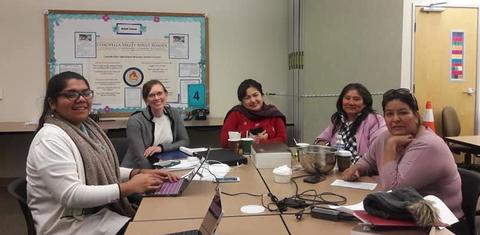Mired in Silence
Health of Southern California’s farmworkers needs to be a priority, says UC Riverside study
AUniversity of California, Riverside, study performed in the Eastern Coachella Valley, one of California’s top agricultural production regions, has found that farmworkers there lack information and the means to advocate for improved public health even when they are aware of being exposed to health risks stemming from working and living in rural farmlands.
About 76% of the 2.4 million farmworkers in the United States are immigrants, most of whom are from Mexico. In Inland Southern California, where the Eastern Coachella Valley, or EVC, is located, not much research has been done on Latinx farmworkers’ health concerns and barriers to care.

Ann Cheney (second from left) is seen here with promotoras, Spanish-speaking community health workers.
“Agricultural production demands in the U.S. impose a heavy burden on Latinx immigrant farmworkers, which shapes their health and informs their decisions about their living conditions,” said Ann Cheney, an associate professor of social medicine, population, and public health in the School of Medicine and lead author of the study that appears in the International Journal of Environmental Research and Public Health. “The health of these workers and their families should be a national priority.”
Cheney and her team used a community-based participatory research approach. They conducted nine in-home meetings in 2017-2018, with the help of “promotoras,” Spanish-speaking community health workers, to gather information on the health concerns of rural residents of the EVC as well as the barriers they face in accessing healthcare services. The majority of the 82 participants in the study were Mexican immigrants, women, and low-income. Nearly 60% of participants worked in agriculture. Many resided close to farmlands and were regularly exposed to pesticides, chemicals, agricultural runoff, and mosquitoes.
In the interviews, participants discussed health concerns related to agricultural labor, such as heat-related illness, musculoskeletal ailments and injuries, skin disorders, respiratory illness, and trauma. They expressed their concerns about environmental exposures related to agriculture and the nearby Salton Sea, a land-locked highly saline lakebed, and offered solutions to improve the health of their communities.
Respiratory illness in the ECV is disproportionately high, affecting about 20% of children living along the Salton Sea. Study participants said they were aware of the negative effects of the Salton Sea on their health.
“Farm work exposes laborers to heat, cold, and ultraviolet rays, increasing the risk to health,” Cheney said. “Farmworkers have more exposure to pesticides than non-agricultural workers, which can increase risk for skin disease, vision problems, and respiratory-associated illness.”
Cheney added that the kind of work the farmworkers do — picking of crops, heavy lifting, and standing or kneeling for long periods — can cause injuries and chronic pain.
“The fast-paced, high-risk working environment can affect mental health,” she said.
The study found many farmworkers stay quiet when it comes to unsafe workplace conditions and injuries because they fear losing their jobs. Many farmworkers lack health insurance and have little access to medical facilities, sick pay, and transportation. Most are not fluent English. Indeed, the situation of rural farmworkers has not changed significantly since the farm labor leader and civil rights activist Cesar Chavez brought attention in the 1960s to the poor living and working conditions endured by farm workers.
“Much of the lack of change is tied to structural level inequities produced by macro-level processes, neoliberal economic and political policies, that extend beyond what individuals or communities can do and reflect the values of governments,” Cheney said. “An example is NAFTA, the North American Free Trade Agreement of 1994. What we know is NAFTA compromised the financial stability of small-scale farms in Mexico, the primary occupation in many rural regions of Mexico. Some estimates suggest more than 3 million people involved in agricultural labor lost their jobs and their livelihood.”
Cheney explained that the EVC is home to a large population of Purépecha, an indigenous group from Michoacán Mexico.
“Living in the valley and working in the fields, they make up an incredibly vulnerable community as many cannot speak Spanish or English,” she said. “They speak their native indigenous language of Purépecha and are undocumented. They choose farm labor because they don’t need language or technical skills to be pickers. This, though, is the lowest ranking position in agricultural labor and least paid.”
According to Cheney, structural level interventions — interventions that change the political and economic landscape — are needed to effect positive change in the lives of farm workers.
“We need to move away from neoliberal policies that privilege those already in positions of power, open the border between US and Mexico so that those crossing the border are not labelled as ‘illegal’ and have the opportunity to find stable employment, access educational and social opportunities for themselves and their families,” she said. “Such an approach also aligns with the thinking of NAFTA — open the borders for trade to eliminate tariffs. We, too, should open the border for human migration to eliminate inequities.”
Cheney was joined in the study by Tatiana Barrera and Katheryn Rodriguez of UCR; and Ana María Jaramillo López of the College of the Northern Border, Tijuana, Mexico.
The research was funded by the Research Program on Migration and Health.
The title of the research paper is “The Intersection of Workplace and Environment Exposure on Health in Latinx Farm Working Communities in Rural Inland Southern California.
Publication: Ann Marie Cheney, et al., The Intersection of Workplace and Environmental Exposure on Health in Latinx Farm Working Communities in Rural Inland Southern California, International Journal of Environmental Research Public Health (2023). DOI: 10.3390/ijerph191912940
Original Story Source: University of California - Riverside

 Alerts Sign-up
Alerts Sign-up